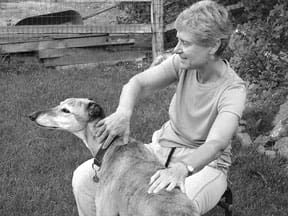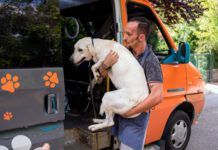By Amy Snow and Nancy Zidonis
What if animal healthcare practitioners were only paid if animals were healthy? In times of old in China that is the way it worked. The Traditional Chinese Medicine (TCM) doctors, known as “barefoot doctors,” would go from village to village and receive housing, food, and payment only if the community was healthy.
The reasoning was simple: If the community was not well, and that often included the animals, it meant the barefoot doctor was not doing a good job, so why should they reward him? When the community was well, they lavished him with riches, food, and elegant accommodations.

288
When you think about it, paying a healthcare practitioner as a reward for good health makes sense. This approach reinforces good health rather than “rewarding” illness. Paying our medical doctors and veterinarians only when we were all healthy would turn conventional healthcare for animals and humans on its head. It must be said, though, that conventional healthcare practitioners have begun to see the virtue of focusing on health and creating illness prevention programs.
Focus on health
Chinese Medicine has always focused on health. From a TCM perspective, most illness is understood as a breakdown of the immune system. When the body’s natural defenses are not strong, external climatic pathogens, such as wind, cold, and heat can “invade” the body and illness can occur. To maintain the body’s defense system the animal must live a balanced, healthy lifestyle.
Supporting a healthy lifestyle for our dogs means natural nutrition, daily exercise, adequate rest, social interaction with other dogs and humans, and avoidance of toxins and stressful environments.
To further contribute to the dog’s health, a TCM practitioner would recommend some form of bodywork. Dog trainers and health-care practitioners can readily offer acu-pressure sessions to support the animal’s health – but so can you, the dog’s guardian! Go barefoot!
A health maintenance acupressure session
Acupressure is noninvasive, safe, and available to everyone. The theoretical basis of acupressure is the same as any other form of Traditional Chinese Medicine: Health is achieved by maintaining the natural balance of energy and other vital substances so that the body’s natural ability to defend itself will be strong. In TCM, life promoting energy is called chi, pronounced “chee,” and also written as “qi” or “ki.”
There are invisible energetic pathways, or channels, throughout the dog’s body. Along these energetic pathways there are specific pools of energy known as acupressure points, or “acupoints.” By using gentle thumb or two-finger pressure on these acupoints we can actually influence the flow of energy along the pathway.
Acupoints have particular energetic attributes. Some acupoints are known to enhance the flow of blood, while other acupoints reduce heat. The selection of an acupoint for inclusion in an acupressure session is based on the point’s energetic characteristics. Note that each acupoint can have several energetic attributes.
For a health maintenance acupressure session we want to select acupoints that have the particular characteristic that will support the smooth and harmonious flow of chi, Blood (in TCM, this means all nutrient-rich fluids), and other body fluids in the dog’s body. This session is like providing your dog with a general, overall tune-up in order to prevent any immune system weakness.
Acupoint selection
In the West, we have taken the liberty of naming acupoints after the energetic pathway or channel on which they are located, as well as numbering them. Each of the major pathways is named after a specific organ system to which it is energetically related.
For instance, the first acupoint included in our health maintenance acupressure session is identified by Western TCM practitioners as Large Intestine 4. The translation of the Chinese name for this acupoint is “Joining Valley,” which is more poetic and descriptive since LI 4 is located on the top-side of the webbing of the dog’s dewclaw. The webbing sort of looks like a joining valley, doesn’t it? If the dog’s dewclaw has been removed, just place your thumb or fingers on top of where it was.
Some of the energetic characteristics of Large Intestine 4 (LI 4) are that it tonifies (i.e., increases the energy of) protective or defensive chi while facilitating the smooth flow of chi throughout the dog’s entire body.
Large Intestine 11 (LI 11) is the next acupoint selected for this acupressure session. LI 11 is known to facilitate the flow of chi and Blood, plus it invigorates Blood, thus improving the circulation of nutrients. The translation of the Chinese name is “Crooked Pond” and it is located in the cubital crease of the dog’s elbow.

288
Stomach 36 (St 36) is a very powerful point that has many energetic characteristics and it is selected for this session because it is one of the most “tonifying” (enhancing) acupoints on the body. St 36 is used to restore collapsed chi, build defensive chi, and defuse pathogenic factors. Its name, “Leg 3 Miles,” refers to the energetic properties this point provides, that is, even if exhausted, by stimulating St 36, the animal’s legs can go another 3 miles.
We need to address the spirit of the dog in this session, too. Governing Vessel 14 is known to calm the spirit and clear the mind. Additionally, GV 14 regulates and facilitates the flow of chi. The point is located on the dorsal midline in the depression at the base of the dog’s neck where there really is a “Big Vertebra” for which it is named.
Most dogs love acupressure on the next point, Bai Hui. It is a traditional point for animals in particular. It is known to distribute Liver chi, which helps regulate the emotions, while it warms and restores collapsed yang energy. Located on the dorsal midline at the sacrum – where it feels flat between the hips, the Bai Hui point is translated from the Chinese as “Point of 100 Meetings” is also known as the dog’s “Heavens Gate.” One explanation for calling it “Heaven’s Gate” for the dog is that the dog’s sacrum is the closest to heaven when he is eating and that’s when he is in heaven!
By placing your thumb, or two fingers, or even scratching on each of these five acupoints bilaterally (on both the sides of the dogs) in turn, you will be able to support your dog’s immune system by balancing his energy and strengthening his body’s natural ability to defend itself against illness. Focusing on health gives your dog real strength.
-Amy Snow and Nancy Zidonis are the authors of The Well-Connected Dog: A Guide to Canine Acupressure, Acu-Cat: A Guide to Feline Acupressure, and Equine Acupressure: A Working Manual. They founded Tallgrass Animal Acupressure Institute, which offers a practitioner certificate program and training programs worldwide, plus books, meridian charts, and videos. Contact them or purchase these products at (888) 841-7211 or www.animalacupressure.com.






